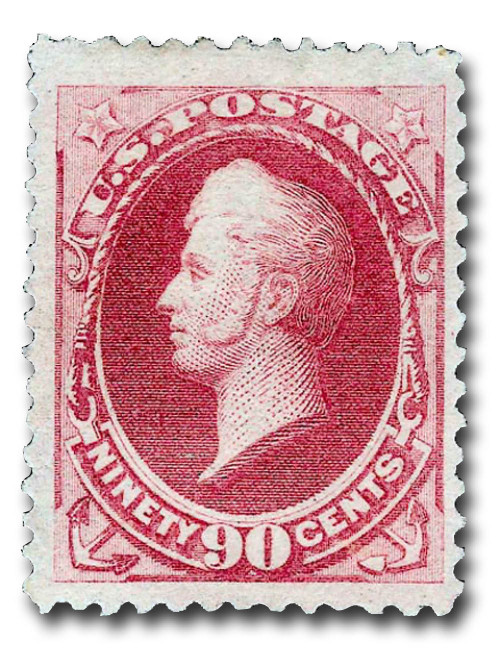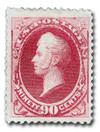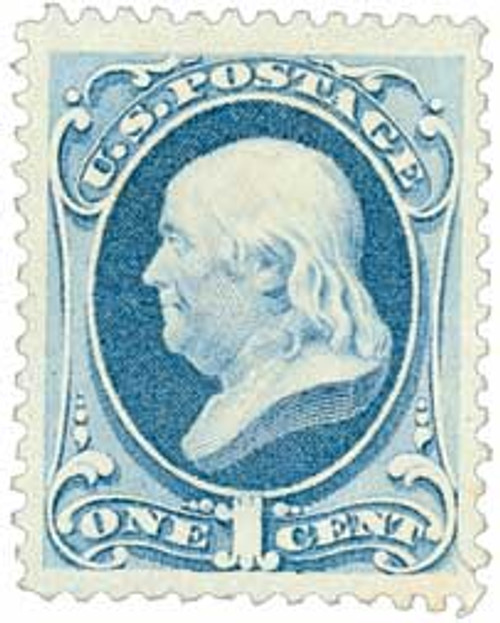
# 191 - 1879 90c Perry, carmine
1879 90¢ Perry
American Bank Note Printing
Earliest Known Use: May 27, 1882
Quantity issued: 280,670 (estimate)
Printed by: American Bank Note Company
Method: Flat plate
Watermark: None
Perforation: 12
Color: Carmine
Birth Of Oliver Perry
Perry was a direct descendant of William Wallace, a leader during the Scottish Wars of Independence. He was also older brother to Matthew Perry, who later opened Japan to the West.
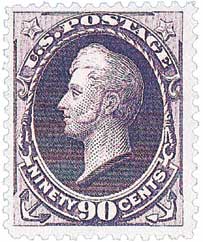
From a young age, Perry learned to sail ships anticipating a career at sea. At the age of 13, he was appointed a midshipman in the United States Navy. He had his first combat experience during the Quasi-War with France in 1800 aboard his father’s ship, the USS General Greene. During that war and the Tripolitan War, he served on such famous ships as the Adams, Constellation, Nautilus, Essex, and Constitution. Perry then served in the First Barbary War, commanding the USS Nautilus and Revenge.
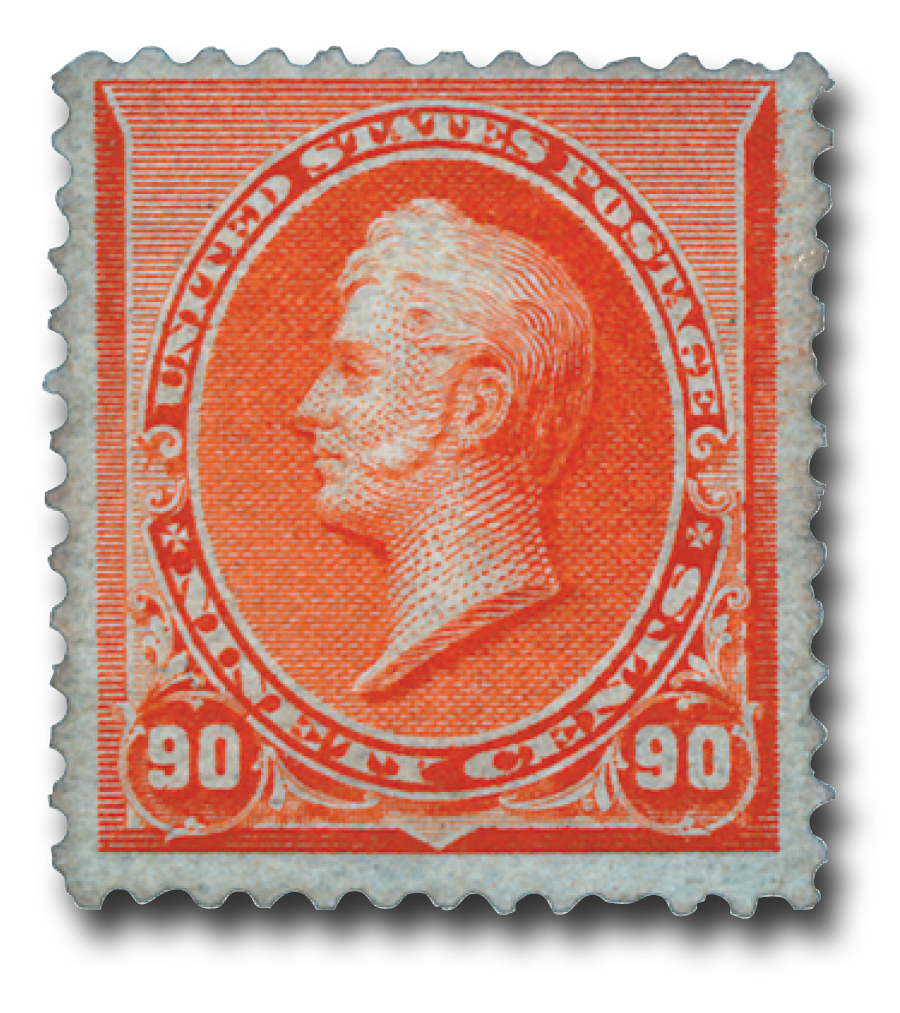
Perry took a leave of absence to get married, but when war was declared in 1812, he sought to join the action. After briefly commanding a small squadron in Newport, he petitioned for a posting at sea. In February 1813, he received orders to report to the Great Lakes to command and oversee construction of a flotilla. It was a busy year for Perry. Upon arrival, he took command and led the defense of Presque Isle. He obtained reinforcements from Lake Ontario and commanded schooners and gunboats at the Battle of Fort George. He also traveled to Black Rock to recover abandoned American vessels that had been taken by the British.
Perry’s other successes included the destruction of British munitions at Fort Erie, overseeing construction of the Erie fleet of ships, getting those ships over the sandbar, blocking British supplies for a month before the battle, and planning the Thames invasion with General William Henry Harrison. Perry also acquired more men for his fleet from the Constitution, which was then undergoing repairs.
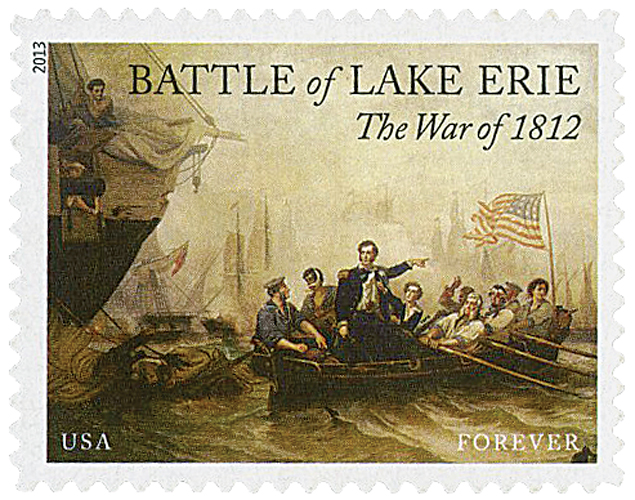
Perry’s leadership was crucial to the success of all nine Lake Erie American victories during the War of 1812. The most famous was the September 10, 1813, battle for which he earned the nickname, “Hero of Lake Erie.” Click here for more on that battle.

Perry went on to serve with distinction, receiving the Congressional Gold Medal and an eventual promotion to commodore. He later commanded the USS Java during the Second Barbary War. In 1819, Perry traveled to Venezuela to discourage piracy and encourage friendly relations. However, after signing the treaty, Perry and much of his crew were stricken with yellow fever. Perry died on August 23, 1819, his 34th birthday.
See more Perry stamps and coins below:
Click here to visit the National Park site for Perry’s Victory and International Peace Memorial in Ohio.
1879 90¢ Perry
American Bank Note Printing
Earliest Known Use: May 27, 1882
Quantity issued: 280,670 (estimate)
Printed by: American Bank Note Company
Method: Flat plate
Watermark: None
Perforation: 12
Color: Carmine
Birth Of Oliver Perry
Perry was a direct descendant of William Wallace, a leader during the Scottish Wars of Independence. He was also older brother to Matthew Perry, who later opened Japan to the West.

From a young age, Perry learned to sail ships anticipating a career at sea. At the age of 13, he was appointed a midshipman in the United States Navy. He had his first combat experience during the Quasi-War with France in 1800 aboard his father’s ship, the USS General Greene. During that war and the Tripolitan War, he served on such famous ships as the Adams, Constellation, Nautilus, Essex, and Constitution. Perry then served in the First Barbary War, commanding the USS Nautilus and Revenge.

Perry took a leave of absence to get married, but when war was declared in 1812, he sought to join the action. After briefly commanding a small squadron in Newport, he petitioned for a posting at sea. In February 1813, he received orders to report to the Great Lakes to command and oversee construction of a flotilla. It was a busy year for Perry. Upon arrival, he took command and led the defense of Presque Isle. He obtained reinforcements from Lake Ontario and commanded schooners and gunboats at the Battle of Fort George. He also traveled to Black Rock to recover abandoned American vessels that had been taken by the British.
Perry’s other successes included the destruction of British munitions at Fort Erie, overseeing construction of the Erie fleet of ships, getting those ships over the sandbar, blocking British supplies for a month before the battle, and planning the Thames invasion with General William Henry Harrison. Perry also acquired more men for his fleet from the Constitution, which was then undergoing repairs.

Perry’s leadership was crucial to the success of all nine Lake Erie American victories during the War of 1812. The most famous was the September 10, 1813, battle for which he earned the nickname, “Hero of Lake Erie.” Click here for more on that battle.

Perry went on to serve with distinction, receiving the Congressional Gold Medal and an eventual promotion to commodore. He later commanded the USS Java during the Second Barbary War. In 1819, Perry traveled to Venezuela to discourage piracy and encourage friendly relations. However, after signing the treaty, Perry and much of his crew were stricken with yellow fever. Perry died on August 23, 1819, his 34th birthday.
See more Perry stamps and coins below:
Click here to visit the National Park site for Perry’s Victory and International Peace Memorial in Ohio.

